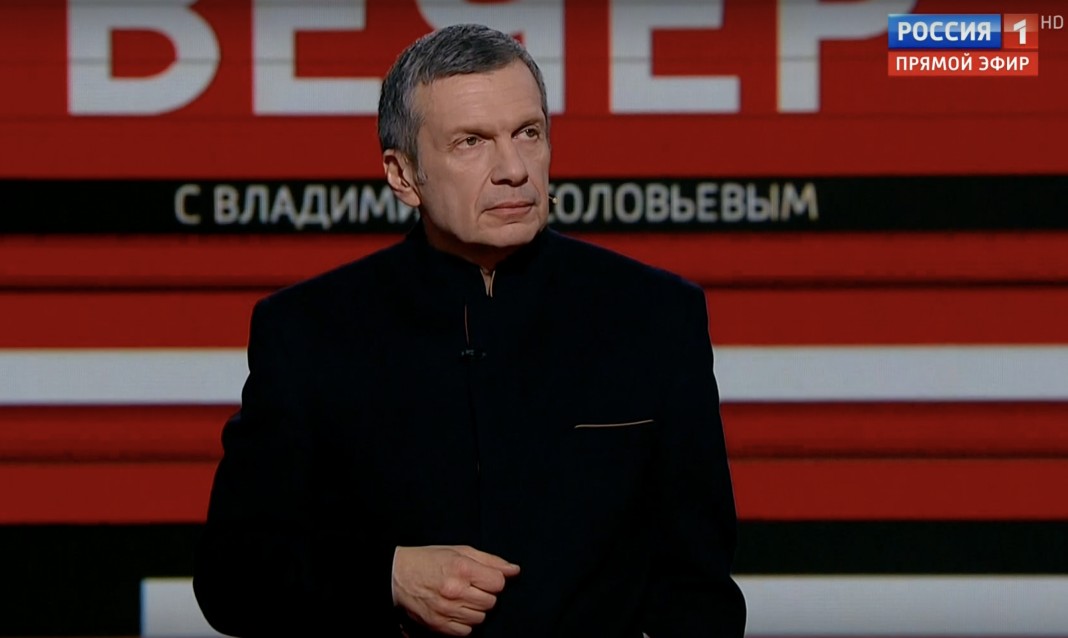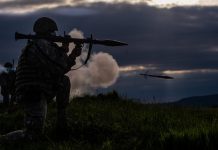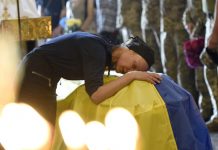By Julis Davis, for CEPA
There was a time, not very long ago, when Russia’s most prominent TV talk show host, Vladimir Solovyov, delighted in warning of a nuclear apocalypse that would hit the US or Britain (but not Russia.) So compelling were these arguments, they once attracted the on-air support of his show’s weather forecaster.
How things change. The first anniversary of Russia’s bloody, all-out invasion seemed to blanket Russian TV sets with doom and gloom. By the end of February 2023, reality crashed the set, joining the once-jolly pundits who used to predict that Ukraine was about to fall and the West would soon back down, in fear of nuclear-armed Russia. The idea that Russia’s victory was far from inevitable and that Russian defeat is a possibility had finally entered the once-impenetrable studios of state media.
Appearing on The Evening With Vladimir Solovyov on February 28, 2023, movie director Karen Shakhnazarov noted: “This situation brings us a danger of very heavy consequences, if we lose. We have to consider the possibility of losing. I disagree with those who say, ‘No need [to consider that], we will win!’ I don’t know about that.”
Solovyov, who once read out lists of the many Western publications mentioning his nuclear threats, suddenly changed his tune on March 6. For the first time in months, discussions about the potential course of Vladimir Putin’s war steered clear of bombastic predictions that London or Washington would soon be wiped off the face of the earth. Solovyov’s tone was dark, prompting his guests to hang their heads. He asked: “Can our army, in its current state, with its current numbers of people and with our military-industrial complex, fulfill its goals — which are not about the war against Ukraine, which does not exist — but against NATO?”
Vitaly Tretyakov, dean of the Moscow State University’s Higher School of Television, failed to read the room. Russia must not agree to any ceasefire or commit to peace talks, since that would “rob Russia’s servicemen of their victories.” Tretyakov then listed various Ukrainian regions, Russifying their names at will and declaring them part of the Russian Federation. He demanded that Russian officials make corresponding proclamations as to the fate of each region. Solovyov’s tone was cold: “Who is supposed to declare it?” Tretyakov replied: “The victors!” The host cut him down: “Seriously? How are they going to attain this victory?”
State Duma deputy Andrey Gurulyov, a former deputy commander of Russia’s southern military district, has likewise frequently appeared on state TV and likewise proposed the use of nuclear weaponry against NATO countries. Now he, too, has changed his tune. Replying to Solovyov’s questions, Gurulyov grimly surmised: “All of us understand very well that we are fighting against NATO, we’ve discussed it on many occasions. I am asked: ‘Can we defeat NATO?’ If you use math and calculate the correlation of forces and means, in the best-case scenario, we can merely defend ourselves.”
It’s hard to be sure how much of the tone change is attributable directly to the talk shows’ Kremlin masters, but we do know that senior media staff receive directions on coverage from the regime, and that these guides are sometimes cut and pasted into media articles. The Kremlin guides also suggest content, as in March 2022 when media were told it was “essential” to quote the Fox News host and Ukrainian war skeptic, Tucker Carlson. We also know that Russian has suffered at least 200,000 casualties and that as a result, ordinary Russians are aware that the conflict is proving extremely difficult, at best. Reality denial is getting harder.
A lot has changed since the first days of Vladimir Putin’s war. In April 2021, long before Putin launched the all-out invasion of his neighbor, state TV hosts, experts, and State Duma members repeatedly stressed that Russia intended to invade Ukraine and warned average Russians about an upcoming war against the collective West. In September 2021, a new national standard for “Urgent burial of corpses in peacetime and wartime” was introduced by the Russian government, set to come into force on February 1, 2022 — the month that the full-scale invasion began. An escalating drumbeat on state TV warned of an upcoming clash, and that it might become nuclear.
After February 22, 2022, state TV’s talking heads continued to cultivate the soil of public opinion, claiming that Russia’s victory was imminent and the West — terrified of its nuclear might — would not only back down, but offer significant concessions. Once it was clear the invasion was stalling, multiple military experts on state TV argued that Russia must now destroy all of Ukraine’s critical infrastructure — long before these strikes commenced in September.
Yet, while the tone has changed, the willingness of state-funded writers and speakers to advocate a continuing war has not altered. While begrudgingly admitting that Russia is not ready to fight NATO and quietly setting aside their nuclear threats, state TV pundits still emphasize the importance of crushing not only Ukrainians—described by Tretyakov as “animals” — but also Russia’s internal opposition, while tirelessly developing various methods of attacking the West in the future.
Russia’s propaganda methods might be shifting, but its rage against those opposing Putin’s bloody pursuit of his imperial ambitions is unsatiated.
By Julis Davis, for CEPA
Julia Davis is a columnist for The Daily Beast and the creator of the Russian Media Monitor. She is a member of the Academy of Television Arts and Sciences, the Screen Actors Guild, and Women In Film.
Europe’s Edge is CEPA’s online journal covering critical topics on the foreign policy docket across Europe and North America. All opinions are those of the author and do not necessarily represent the position or views of the institutions they represent or the Center for European Policy Analysis.





